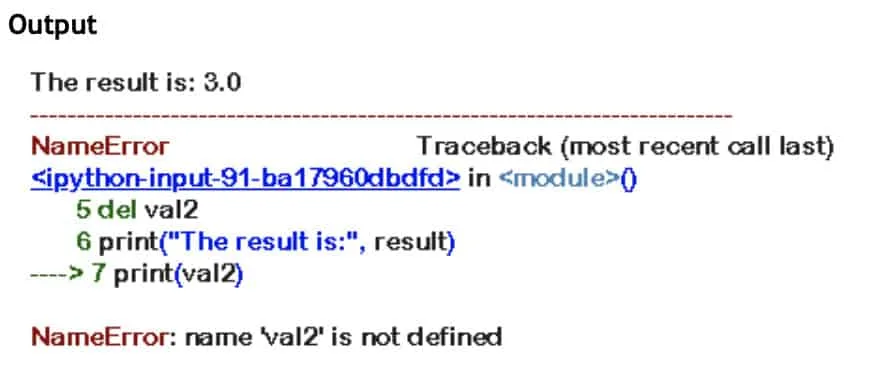Today, we will learn how to clear variables in Python. Let’s say you created a variable initially and no longer require it.
So, keeping it is useless and is wasting memory as well. Therefore, you can do two things. If the variable is not required later, you can delete it completely. Otherwise, you can clear its value.
How to Delete a variable in Python
If you delete a variable, you cannot use it later as it will be removed from the memory. You can delete a variable using the del keyword. Let’s take an example.
val1 = 15
val2 = 5
result = val1/val2
del val1
del val2
print("The result is:", result)
Output
The result is: 3.0
Since val1 and val2 are not required, we delete them. If we try to refer to it later, we will get an error. Let’s see.
val1 = 15
val2 = 5
result = val1/val2
del val1
del val2
print("The result is:", result)
print(val2)

How to Clear Variables in Python Output
How to Delete All Variables in Python
If you want to delete all the created variables, you can also do that. The dir() method returns the list of names in the current local scope.
If the variable does not start with __, then it is a user-defined variable. Therefore, you can delete it using the globals() method. It returns a dictionary that contains the global variables of the current scope.
To delete all variables in Python, see this code:
val1 = 15
val2 = 5
result = val1/val2
objects = dir()
for obj in objects:
if not obj.startswith("__"):
del globals()[obj]
If we try to access a user-defined object now, we will get an error.
print(result)

Output clearing values in Python
Note that if you start your variable with __, then it won’t get deleted because you are excluding such types of names. You will have to remove it manually.
How to Clear the Value of a Variable in Python
Clearing the value of the variable is quite simple. We only have to assign None to it. Note that the variable still exists in the memory, and therefore you can refer to it. It just does not have any value assigned to it.
Let’s have a look at an example.
To clear the value of a variable in Python, see this code:
val1 = 15
val2 = 5
result = val1/val2
val1 = val2 = None #clearing values
print("The result is:", result)
print(val1, val2)
Output
The result is: 3.0 None None

Hey guys! It’s me, Marcel, aka Maschi. On MaschiTuts, it’s all about tutorials! No matter the topic of the article, the goal always remains the same: Providing you guys with the most in-depth and helpful tutorials!


